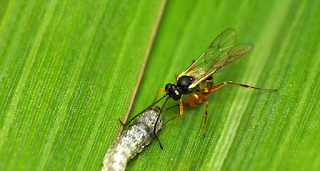Plants can call for help
Plants are immobile; they can't run away from danger. But they have evolved various ways to protect themselves, for example, with sharp thorns or thick tree bark. Some plants even produce chemicals that are foul-tasting to invaders, which makes them less tasty and more likely to be avoided. Some make toxic substances, and others make chemicals that slow the growth rate of plant eaters. But some have found a way to call for help against predators. How do they do that?
In the 1980s, University of Amsterdam scientists Marcel Dicke and Maurice Sabelis studied lima bean plants and their enemy, spider mites. When spider mites Tetranychus urticae attacked the plants, the damaged leaves in the top of the plant released 4 chemicals that are different from the ones released when leaves are mechanically damaged by other means. These four were specific "infochemicals" which female predatory mites (P-mites) use to locate and eat the spider mite and its eggs. The infochemicals were specific to attract the P-mites!
Swiss entomologist Thomas Degen in 2012 inoculated corn plant tops with an armyworm caterpillars using a spring-loaded "bazooka" and waited for them to feast on the corn. After that, he measured two things. Growing 6 types of corn in a lab, he placed a plastic bag over the top of the corn where the worms were eating, and using a pair of pumps, Degen could suck out air containing volatile chemicals (volatile means they evaporate easily into the surrounding air) that the plants made and replace it with fresh air.
Then, he analyzed the volatiles and found 36 chemicals were released. Six corn varieties each made different amounts, with the largest amount 15 times more concentrated than the lowest corn variety. And infested plants made more chemicals than controls with no infestations. He also noticed that the size of the worm larvae were smaller when the chemical concentration was higher.
More recently, Lei Wang at the University of Bern in Switzerland has also studied corn to see what chemicals are released, and he saw a similar thing. Older plants don't make as much anti-predator warning chemicals.
Nobody knows why young plant leaves do this better than old ones. They might be predisposed to doing it because the plant is still growing instead of at rest, and it may be more vulnerable then. New leaves are on the top of the plants, so the mechanism for chemical release might have evolved to take advantage of wind there. It's a pretty sensitive issue for growing plants, too. Ian Baldwin of the Max Planck Institute for Chemical Ecology in Germany showed as far back as 1983 that even if 7% of leaf damage was sustained by one plant, that was enough to send out a chemical signal in 1.5-2 days to warn neighboring plants.
What is known is that some plants recognize chemicals in the saliva of an attacking insect larva, and that triggers the defensive release of the volatile plant chemicals. This is not limited to one species protecting its neighbors of the same species. Richard Karban (University of California - Davis) showed that damaging sagebrush can cause nearby tobacco plants to produce defensive chemicals. He toned down the name "plant communication" from one to another to a more casual term of "plant eavesdropping" to describe what may actually be happening. This might be because the signaling operates only within 50-100 cm (20-40 inches) from the plant.
One benefit from these studies was expressed by Wang. Perhaps science could develop crops that are better at doing this and "smarter" to resist predators.
For an historical perspective on learning how plants defend themselves, check out this link.






No comments:
Post a Comment